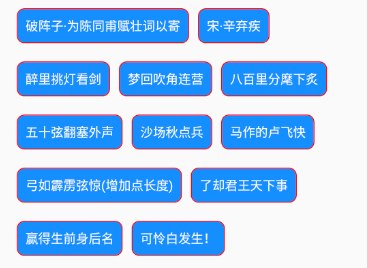
1.创建CustomLayout继承ViewGroup
/**
- 编写自定义ViewGroup的示例。
*/
public class CustomLayout extends ViewGroup {
// private int childHorizontalSpace = 20;
// private int childVerticalSpace = 20;
private int childHorizontalSpace;
private int childVerticalSpace;
//从代码创建视图时使用的简单构造函数。
public CustomLayout(Context context) {
super(context);
}
//从XML使用视图时调用的构造函数。
public CustomLayout(Context context, AttributeSet attrs) {
super(context, attrs);
TypedArray attrArray = context.obtainStyledAttributes(attrs, R.styleable.CustomLayout);
if (attrArray != null) {
childHorizontalSpace = attrArray.getDimensionPixelSize(R.styleable.CustomLayout_horizontalSpace, 12);
childVerticalSpace = attrArray.getDimensionPixelSize(R.styleable.CustomLayout_verticalSpace, 12);
MLog.e(getClass().getName(),“HorizontalSpace:”+childHorizontalSpace+“|VerticalSpace:”+childVerticalSpace);
attrArray.recycle();
}
//此视图是否自行绘制
setWillNotDraw(false);
}
/**
- 负责设置子控件的测量模式和大小 根据所有子控件设置自己的宽和高
*/
@Override
protected void onMeasure(int widthMeasureSpec, int heightMeasureSpec) {
super.onMeasure(widthMeasureSpec, heightMeasureSpec);
MLog.e(getClass().getName(),“onMeasure”);
// 获得它的父容器为它设置的测量模式和大小
int sizeWidth = MeasureSpec.getSize(widthMeasureSpec);
int sizeHeight = MeasureSpec.getSize(heightMeasureSpec);
int modeWidth = MeasureSpec.getMode(widthMeasureSpec);
int modeHeight = MeasureSpec.getMode(heightMeasureSpec);
// 如果是warp_content情况下,记录宽和高
int width = 0;
int height = 0;
//记录每一行的宽度,width不断取最大宽度
int lineWidth = 0;
//每一行的高度,累加至height
int lineHeight = 0;
int count = getChildCount();
int left = getPaddingLeft();
int top = getPaddingTop();
// 遍历每个子元素
for (int i = 0; i < count; i++) {
View child = getChildAt(i);
if (child.getVisibility() == GONE)
continue;
// 测量每一个child的宽和高
measureChild(child, widthMeasureSpec, heightMeasureSpec);
// 得到child的lp
ViewGroup.LayoutParams lp = child.getLayoutParams();
// 当前子空间实际占据的宽度
int childWidth = child.getMeasuredWidth() + childHorizontalSpace;
// 当前子空间实际占据的高度
int childHeight = child.getMeasuredHeight() + childVerticalSpace;
if (lp != null && lp instanceof MarginLayoutParams) {
MarginLayoutParams params = (MarginLayoutParams) lp;
childWidth += params.leftMargin + params.rightMargin;
childHeight += params.topMargin + params.bottomMargin;
}
//如果加入当前child,则超出最大宽度,则的到目前最大宽度给width,类加height 然后开启新行
if (lineWidth + childWidth > sizeWidth - getPaddingLeft() - getPaddingRight()) {
width = Math.max(lineWidth, childWidth);// 取最大的
lineWidth = childWidth; // 重新开启新行,开始记录
// 叠加当前高度,
height += lineHeight;
// 开启记录下一行的高度
lineHeight = childHeight;
child.setTag(new Location(left, top + height, childWidth + left - childHorizontalSpace, height + child.getMeasuredHeight() + top));
} else {
// 否则累加值lineWidth,lineHeight取最大高度
child.setTag(new Location(lineWidth + left, top + height, lineWidth + childWidth - childHorizontalSpace + left, height + child.getMeasuredHeight() + top));
lineWidth += childWidth;
lineHeight = Math.max(lineHeight, childHeight);
}
}
width = Math.max(width, lineWidth) + getPaddingLeft() + getPaddingRight();
height += lineHeight;
sizeHeight += getPaddingTop() + getPaddingBottom();
height += getPaddingTop() + getPaddingBottom();
setMeasuredDimension((modeWidth == MeasureSpec.EXACTLY) ? sizeWidth : width, (modeHeight == MeasureSpec.EXACTLY) ? sizeHeight : height);
}
/**
- 记录子控件的坐标
*/
public class Location {
public Location(int left, int top, int right, int bottom) {
this.left = left;
this.top = top;
this.right = right;
this.bottom = bottom;
}
public int left;
public int top;
public int right;
public int bottom;
}
//计算当前View以及子View的位置
@Override
protected void onLayout(boolean changed, int l, int t, int r, int b) {
MLog.e(getClass().getName(),“onLayout”);
//获取子View个数
int count = getChildCount();
for (int i = 0; i < count; i++) {
//获取子View
View child = getChildAt(i);
//判断是否显示
if (child.getVisibility() == GONE)
continue;
//获取子View的坐标
Location location = (Location) child.getTag();
//设置子View位置
child.layout(location.left, location.top, location.right, location.bottom);
}
}
@Override
protected void onSizeChanged(int w, int h, int oldw, int oldh) {
super.onSizeChanged(w, h, oldw, oldh);
MLog.e(getClass().getName(),“onSizeChanged”);
}
@Override
protected void onDraw(Canvas canvas) {
super.onDraw(canvas);
MLog.e(getClass().getName(),“onDraw”);
}
}
2.使用自定义CustomLayout
<?xml version="1.0" encoding="utf-8"?><com.scc.demo.view.CustomLayout xmlns:android=“http://schemas.android.com/apk/res/android”
xmlns:custom=“http://schemas.android.com/apk/res-auto”
android:layout_width=“match_parent”
android:layout_height=“match_parent”
android:layout_margin=“@dimen/dimen_20”
custom:horizontalSpace=“10dp”
custom:verticalSpace=“20dp”>
<TextView
style=“@style/TvStyle”
android:text=“破阵子·为陈同甫赋壮词以寄” />
<TextView
style=“@style/TvStyle”
android:text=“宋·辛弃疾” />
<TextView
style=“@style/TvStyle”
android:text=“醉里挑灯看剑” />
<TextView
style=“@style/TvStyle”
android:text=“梦回吹角连营” />
<TextView
style=“@style/TvStyle”
android:text=“八百里分麾下炙” />
<TextView
style=“@style/TvStyle”
android:text=“五十弦翻塞外声” />
<TextView
style=“@style/TvStyle”
android:text=“沙场秋点兵” />
<TextView
style=“@style/TvStyle”
android:text=“马作的卢飞快” />
<TextView
style=“@style/TvStyle”
android:text=“弓如霹雳弦惊(增加点长度)” />
<TextView
style=“@style/TvStyle”
android:text=“了却君王天下事” />
<TextView
style=“@style/TvStyle”
android:text=“赢得生前身后名” />
<TextView
style=“@style/TvStyle”
android:text=“可怜白发生
!” />
</com.scc.demo.view.CustomLayout>
自定义属性
在app/src/main/res/values/attrs.xml中添加属性
<?xml version="1.0" encoding="utf-8"?>使用自定义属性
- 在xml中使用
一定要添加:xmlns:test=”schemas.android.com/apk/res-aut…
<com.scc.demo.view.CustomLayout xmlns:android=“http://schemas.android.com/apk/res/android”
xmlns:custom=“http://schemas.android.com/apk/res-auto”
android:layout_width=“match_parent”
android:layout_height=“match_parent”
android:layout_margin=“@dimen/dimen_20”
custom:horizontalSpace=“10dp”
custom:verticalSpace=“20dp”>
</com.scc.demo.view.CustomLayout>
- 在代码中使用
TypedArray attrArray = context.obtainStyledAttributes(attrs, R.styleable.CustomLayout);
if (attrArray != null) {
//参数1:获取xml中设置的参数;参数2:获取失败2使用参数作为默认值
childHorizontalSpace = attrArray.getDimensionPixelSize(R.styleable.CustomLayout_horizontalSpace, 12);
childVerticalSpace = attrArray.getDimensionPixelSize(R.styleable.CustomLayout_verticalSpace, 12);
MLog.e(getClass().getName(),“HorizontalSpace:”+childHorizontalSpace+“|VerticalSpace:”+childVerticalSpace);
//TypedArray对象池的大小默认为5,使用时记得调用recyle()方法将不用的对象返回至对象池来达到重用的目的。
最后
小编这些年深知大多数初中级Android工程师,想要提升自己,往往是自己摸索成长,自己不成体系的自学效果低效漫长且无助。
因此我收集整理了一份《2024年Android移动开发全套学习资料》,初衷也很简单,就是希望能够帮助到想自学提升又不知道该从何学起的朋友。

一个人可以走的很快,但一群人才能走的更远!不论你是正从事IT行业的老鸟或是对IT行业感兴趣的新人
都欢迎加入我们的的圈子(技术交流、学习资源、职场吐槽、大厂内推、面试辅导),让我们一起学习成长!
资料⬅专栏获取
ayout_verticalSpace, 12);
MLog.e(getClass().getName(),“HorizontalSpace:”+childHorizontalSpace+“|VerticalSpace:”+childVerticalSpace);
//TypedArray对象池的大小默认为5,使用时记得调用recyle()方法将不用的对象返回至对象池来达到重用的目的。
最后
小编这些年深知大多数初中级Android工程师,想要提升自己,往往是自己摸索成长,自己不成体系的自学效果低效漫长且无助。
因此我收集整理了一份《2024年Android移动开发全套学习资料》,初衷也很简单,就是希望能够帮助到想自学提升又不知道该从何学起的朋友。
[外链图片转存中…(img-Gz2Qjvh5-1718987546107)]
一个人可以走的很快,但一群人才能走的更远!不论你是正从事IT行业的老鸟或是对IT行业感兴趣的新人
都欢迎加入我们的的圈子(技术交流、学习资源、职场吐槽、大厂内推、面试辅导),让我们一起学习成长!
资料⬅专栏获取






![[19] Opencv_CUDA应用之 基于形状的对象检测与跟踪](http://pic.xiahunao.cn/[19] Opencv_CUDA应用之 基于形状的对象检测与跟踪)




通信接口)





详解)

,彻底掌握参数传递)